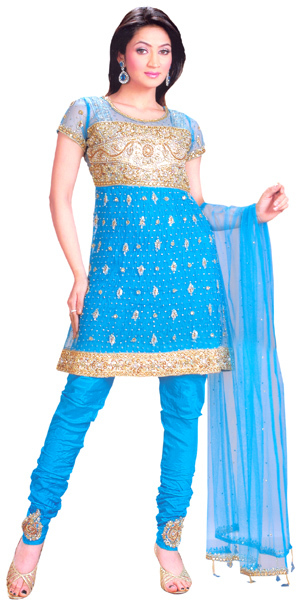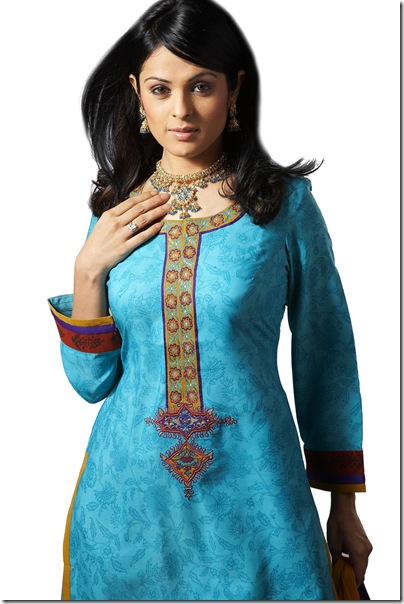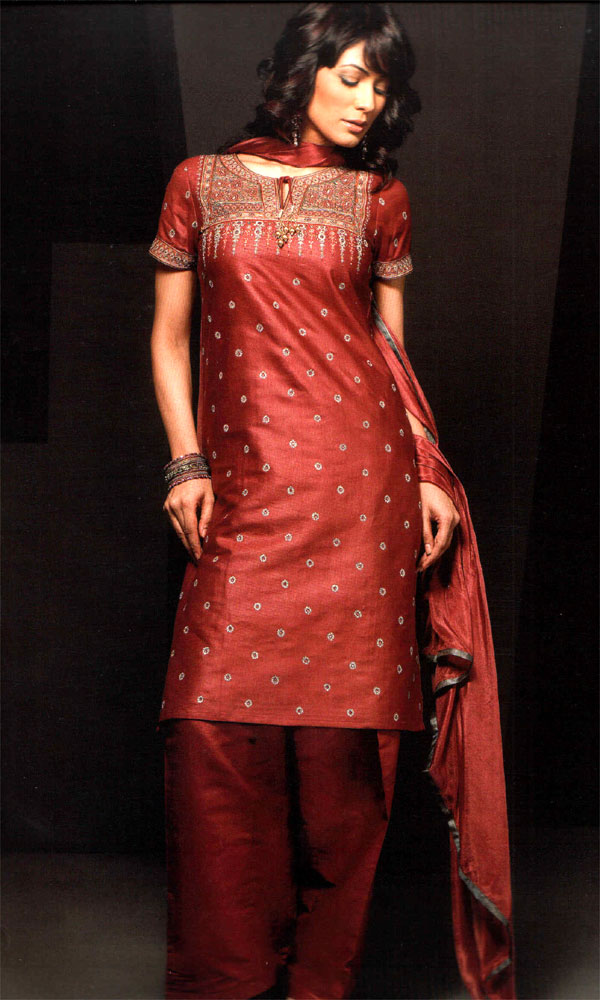Source(google.com.pk)
Salwar Kurta Biography
The Salwar Kurta is widely regarded as the most comfortable of all Indian garments. The variation in styles allows easy movement as well as versatility. Once the proper fabric for the suit is chosen, it is time for the artisan to display his handiwork. Hand worked fabrics are those which are embroidered or embellished using manual skills. Flawless hand embroidery requires a lot of dexterity and patience. India is famous for it’s regional styles of needlework and has numerous artisans all over the country who are experts in provincial embroidery work.
The most widely preferred of all Indian needlecraft is the renowned Lucknowi chikankari. Chikankari salwar kurtas are very popular because of their elegant style as well as the comfort factor. Chikankari is also practiced in Rampur and Agra, both of which are well known too. Chikankari work consists of delicate floral designs stitched onto fine cotton or muslin cloth. Other than chikankari, the hand painted designs and Jamdani weave of Faizabad is also quite admired.The half-saree of south India is very age-specific, unlike the saree or the salwar-kameez. It solely belongs to the young generation and no woman past her teens would generally wear it. The half-saree scripts a sartorial evolution from girlhood to womanhood. It combines the feistiness of a girl with the feminine elegance of a young woman. That is one cause possibly why south Indian filmmakers are rediscovering the half-saree, giving the piece of clothing a fresh lease of life.
Half Saree was very common among young girls of Kerala and Tamil Nadu. Full skirt, short blouse and a davani (shawl) constitutes this dressing style. It is considered to be originated in Tamil Nadu, but is very commonly used in Kerala till about 30 years back. These days with all contemporary fashions, half saree has almost entirely disappeared among Kerala girls.
If the songs, `Pavada prayathil' and `Pavadai davaniyil', were to be written at present, the lyrics would not be the same anymore, for, the pavada is almost missing from the Malayali girl's wardrobe. In Kerala, only the `audacious’ wore the salwar kurta two decades ago. The foray of the electronic media and salwar kurtas found their way into the hearts of Malayali girls. If you want to see Malayali girls in pattu pavada-blouse sets in our day, then you have to be invited to a marriage ceremony. Or you should stopover a temple or wait for November 1 (Kerala Piravi Day).
Traditionalists, however, need not fret. A few still favor the Indian pavada. Young girls are still getting pavadas stitched. But it's impractical to think that pavada will be worn as it used to be 15 to 20 years ago. But things now have enhanced from the way it was five years ago, when the pavada or the half sari was barely seen. Wearing pavada and blouse in everyday life is very uncomfortable and tiresome. Getting on and off buses, in weighty pavadas, is very difficult. It is an ornamental outfit, and not a functional one. Hence, it is best to wear it on choice occasions. Most people buy it only once a year, during Onam, and that's the only time it is hugely worn.
Even mothers don't want to compel their daughters to wear the Indian pavada today. Of course, the pavada is very gorgeous and traditional and mothers, however, would love to see their daughters wear the pavada-blouse often. It gives a certain distinguished look to the teenager. Just as the sari has displaced the mundum neriaythum, salwar kurtas have replaced the pavada – blouse. Pavada often means the pattu pavada, stitched in shimmering Kancheevaram. For some people the pavada is made in no other material. The flamboyance is part of the fashion statement it makes. But Pavadas in printed georgette or other synthetic fabrics, which make good formal as well as casual wear, were admired even a decade ago.












Salwar Kurta Biography
The Salwar Kurta is widely regarded as the most comfortable of all Indian garments. The variation in styles allows easy movement as well as versatility. Once the proper fabric for the suit is chosen, it is time for the artisan to display his handiwork. Hand worked fabrics are those which are embroidered or embellished using manual skills. Flawless hand embroidery requires a lot of dexterity and patience. India is famous for it’s regional styles of needlework and has numerous artisans all over the country who are experts in provincial embroidery work.
The most widely preferred of all Indian needlecraft is the renowned Lucknowi chikankari. Chikankari salwar kurtas are very popular because of their elegant style as well as the comfort factor. Chikankari is also practiced in Rampur and Agra, both of which are well known too. Chikankari work consists of delicate floral designs stitched onto fine cotton or muslin cloth. Other than chikankari, the hand painted designs and Jamdani weave of Faizabad is also quite admired.The half-saree of south India is very age-specific, unlike the saree or the salwar-kameez. It solely belongs to the young generation and no woman past her teens would generally wear it. The half-saree scripts a sartorial evolution from girlhood to womanhood. It combines the feistiness of a girl with the feminine elegance of a young woman. That is one cause possibly why south Indian filmmakers are rediscovering the half-saree, giving the piece of clothing a fresh lease of life.
Half Saree was very common among young girls of Kerala and Tamil Nadu. Full skirt, short blouse and a davani (shawl) constitutes this dressing style. It is considered to be originated in Tamil Nadu, but is very commonly used in Kerala till about 30 years back. These days with all contemporary fashions, half saree has almost entirely disappeared among Kerala girls.
If the songs, `Pavada prayathil' and `Pavadai davaniyil', were to be written at present, the lyrics would not be the same anymore, for, the pavada is almost missing from the Malayali girl's wardrobe. In Kerala, only the `audacious’ wore the salwar kurta two decades ago. The foray of the electronic media and salwar kurtas found their way into the hearts of Malayali girls. If you want to see Malayali girls in pattu pavada-blouse sets in our day, then you have to be invited to a marriage ceremony. Or you should stopover a temple or wait for November 1 (Kerala Piravi Day).
Traditionalists, however, need not fret. A few still favor the Indian pavada. Young girls are still getting pavadas stitched. But it's impractical to think that pavada will be worn as it used to be 15 to 20 years ago. But things now have enhanced from the way it was five years ago, when the pavada or the half sari was barely seen. Wearing pavada and blouse in everyday life is very uncomfortable and tiresome. Getting on and off buses, in weighty pavadas, is very difficult. It is an ornamental outfit, and not a functional one. Hence, it is best to wear it on choice occasions. Most people buy it only once a year, during Onam, and that's the only time it is hugely worn.
Even mothers don't want to compel their daughters to wear the Indian pavada today. Of course, the pavada is very gorgeous and traditional and mothers, however, would love to see their daughters wear the pavada-blouse often. It gives a certain distinguished look to the teenager. Just as the sari has displaced the mundum neriaythum, salwar kurtas have replaced the pavada – blouse. Pavada often means the pattu pavada, stitched in shimmering Kancheevaram. For some people the pavada is made in no other material. The flamboyance is part of the fashion statement it makes. But Pavadas in printed georgette or other synthetic fabrics, which make good formal as well as casual wear, were admired even a decade ago.
Salwar Kurta

Salwar Kurta

Salwar Kurta

Salwar Kurta

Salwar Kurta

Salwar Kurta

Salwar Kurta

Salwar Kurta

Salwar Kurta

Salwar Kurta

Salwar Kurta

Salwar Kurta

Salwar Kurta
Chikan suit is very prominent dress in entire north India. Salwar Kurta with hand embroidery on neck looks very traditional.
ReplyDeleteEmbroidery Kurtas
Ladies Kurtis (Tunics) have become the most common trendy and casual wear in the recent years. Girls and women prefer to wear Indian Bollywood Fashion Kurtis, tunics, designer kurtis, cotton kurtas or a short kurta with jeans for their daily use. Designer Kurti, Embroidery Tunics and Cotton Kurtas are good for college and office use. These are not just trendy but attractive in design and enriches your beauty.
ReplyDeleteBuy Womens Clothing Online